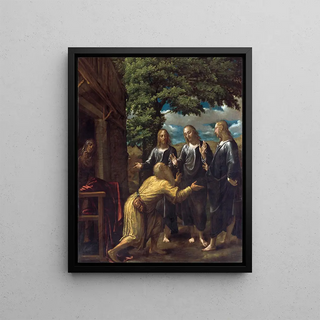Art print | Abraham and the Three Angels - Juan Fernández de Navarrete


View from behind

Frame (optional)
The art print "Abraham and the Three Angels" by Juan Fernández de Navarrete is a true invitation to immerse oneself in the fascinating world of 17th-century religious art. This painting, emblematic of Spanish painting, depicts a biblical scene rich in symbolism and emotion. The encounter between Abraham and the three angels, set in an environment that is both intimate and solemn, showcases the narrative depth of Navarrete's art. As viewers scrutinize this piece, they are transported to a moment of grace and revelation, where divine light appears to bathe the characters in a sacred aura.
Style and uniqueness of the art print
The uniqueness of "Abraham and the Three Angels" lies in how Navarrete manages to capture the very essence of spirituality. His use of light, both gentle and penetrating, creates a striking contrast between the figures and the background. The faces of the angels, imbued with serenity and benevolence, are rendered with such precision that their expressions almost seem tangible. The color palette, subtly chosen, oscillates between warm tones and cooler shades, further enhancing the atmosphere of mystery and devotion emanating from the scene. Every detail, from the drapery of the robes to the surrounding natural elements, is treated with meticulous care, reflecting the artist's expertise. This art print is not merely a depiction of a biblical event but also an exploration of human emotions in the face of transcendence.
The artist and his influence
Juan Fernández de Navarrete, nicknamed "the Monk of El Escorial," is an emblematic figure of Spanish painting during the Golden Age. Trained in the shadow of great masters, he developed a style that is uniquely his own, combining technical rigor with profound spirituality. His work reflects an intimate understanding of sacred texts, which he translates into harmonious compositions and lively characters. Navarrete's influence extends beyond his era, inspiring many artists who sought to capture light and grace in their own works.

Matte finish

View from behind

Frame (optional)
The art print "Abraham and the Three Angels" by Juan Fernández de Navarrete is a true invitation to immerse oneself in the fascinating world of 17th-century religious art. This painting, emblematic of Spanish painting, depicts a biblical scene rich in symbolism and emotion. The encounter between Abraham and the three angels, set in an environment that is both intimate and solemn, showcases the narrative depth of Navarrete's art. As viewers scrutinize this piece, they are transported to a moment of grace and revelation, where divine light appears to bathe the characters in a sacred aura.
Style and uniqueness of the art print
The uniqueness of "Abraham and the Three Angels" lies in how Navarrete manages to capture the very essence of spirituality. His use of light, both gentle and penetrating, creates a striking contrast between the figures and the background. The faces of the angels, imbued with serenity and benevolence, are rendered with such precision that their expressions almost seem tangible. The color palette, subtly chosen, oscillates between warm tones and cooler shades, further enhancing the atmosphere of mystery and devotion emanating from the scene. Every detail, from the drapery of the robes to the surrounding natural elements, is treated with meticulous care, reflecting the artist's expertise. This art print is not merely a depiction of a biblical event but also an exploration of human emotions in the face of transcendence.
The artist and his influence
Juan Fernández de Navarrete, nicknamed "the Monk of El Escorial," is an emblematic figure of Spanish painting during the Golden Age. Trained in the shadow of great masters, he developed a style that is uniquely his own, combining technical rigor with profound spirituality. His work reflects an intimate understanding of sacred texts, which he translates into harmonious compositions and lively characters. Navarrete's influence extends beyond his era, inspiring many artists who sought to capture light and grace in their own works.






